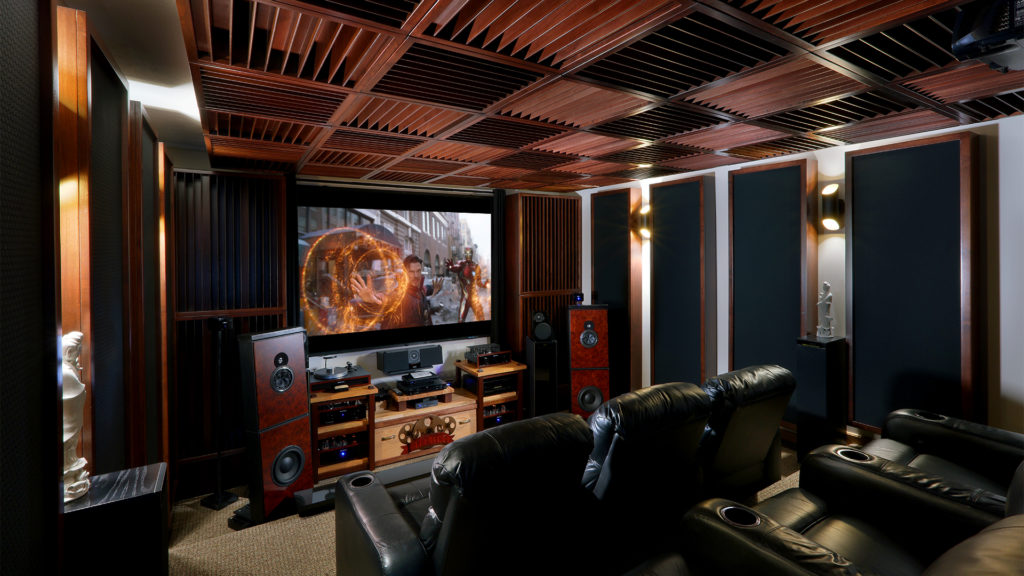
The term sound deadening panel is a misnomer. Let’s break apart the term sound deadening panel and look at each of its parts as they relate to a particular function. What is a sound deadening panel? If we are using the term sound deadening are we wanting a panel that will absorb excess sound energy. If this is the objective, then what frequencies of energy do we wish to absorb. Are we going after lower, bass, frequencies? Are we going to focus on middle and high frequencies where voice and music exist? We must decide what frequency issues are before we use any type of sound deadening panel type.
Examine your room first
How do we figure out all of these sonic variables? We must first look at your room as a whole. What are the room dimensions? Do they match what you wish to do within the room? This is termed usage. Does your usage match the room size or are you doing too much in too small of a space. Are you creating more energy issues than the room can manage? Remember the acoustic goal is to do no more harm than the room already is going to do. Let’s simplify things. We must start with a rigid examination of the room size and usage.

Free Acoustic Room Analysis
At Acoustic Fields, we have our room form process. The room form gathers all the most important data that we will need to determine and sound deadening panel type that we may need to treat the room with. The room form will tell us what lower frequency issues we will have based upon what we intend to do within the room itself. Matching the room size and volume to the usage is critical. As usual with humans, they try to do too much in too small of a room.

Decorative soundproof wall panels or sound diffusion?
The room form will also let you attach up to six pictures with the data. Stand in the middle of the room and take a pic of each wall surface area along with the floor and ceiling. The pics will show us the viable surface for treatment. Whether we will use soundproofing wall panels or maybe a diffusion treatment type, the room form data will go a long way to help us answer all of our questions and relate what we are going to do within the room with the room size and volume.
Find out more about our Recording Studio Design Services.

Once you have filled out all the room form data, you will then submit the form and follow the softwares’ instructions and schedule a time slot to speak with our designers. There are many issues that must be resolved during the design phase. You must look at what you are going to do within the room. Each usage requires different treatment amounts and positions. The usage will determine how much energy that you will place within the room.
Reducing reverberation using the best sound proof panels
Remember that the room only sees frequency and amplitude. The room only sees energy. Certain room sizes and volumes will only hold so much energy. Think of your room as 16 oz. glass for water. You will place 24 oz. of water in your 16 oz. glass. The 8 oz. that spill out are room distortions such as room modes at lower frequencies and reverberation. Reverberation is defined as how long a sound stays around within the room after it has been sung, spoken, or played.

Sound deadening panels for your studio or home theater
Once you get all the internal energy issues calculated and the usage specified, you must then prescribe the amounts of treatment and their specific types. Starting with low-frequency management first, we must decide if we are building the low frequency management into the walls or are we going to use freestanding units. With low-frequency management it is all about providing enough surface area coverage to treat the unwanted frequency and amplitude (strength) issues.
Reducing modal issues
You must cover each offending wall and floor or ceiling when treating low frequency issues. The floor to ceiling dimension is the smallest of the three when you consider width and length. With low -frequency issues, the smallest room dimensions create the largest modal issues. With most small rooms that are concerned with achieving a higher degree of low-frequency resolution we must treat the floor or ceiling or in some cases both surfaces.
Find out more about our Home Theater Design Services.
Middle and high frequency reflections from our wall surfaces produce reverberation. Reverberation is defined as to how long a sound stays around within the room after it has been sung, spoken, or played. High reverberation times lower speech intelligibility ratings where you will not be able to understand most words in a 10 word sentence. Reverberation from the room walls, floor, and ceiling confuse the straight line energy from our sound sources.
Best room size & volume chart
The direct line energy is the energy we want to hear. It travels the shortest distance to us since it travels in a straight line. Reflections cross over the straight line direct energy from our speakers which is the cleanest sound. Straight line energy has less room sound since it is not reflection based. All room sonic presentation value is composed of a mix of direct and reflected energy. The goal with proper design is to balance those two energies correctly so you are listening to the music without hearing the room.








